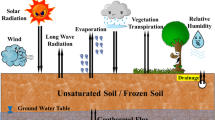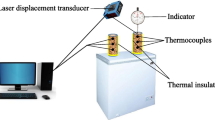Abstract
The depth to which freezing and thawing may occur in soils is important to the design of pavements, embankments, structures and utilities in areas of seasonal frost and permafrost. In the prediction equations the material property and surface energy input parameters (e.g. air temperature, cloud cover, snow cover) are often assumed to be deterministic. In reality the input parameters are not fixed values but random variables. A probabilistic analysis may be performed using a deterministic model and the probability density function for the input parameters. To illustrate the probabilistic approach, an example of the prediction of thaw depths in Fairbanks, Alaska, is considered. More specifically, the Stefan equation and modified Berggren equation are used together with the Monte Carlo simulation technique to make a probabilistic prediction of thaw penetration. The simulation results indicate that the variability in material properties, surface energy input parameters and temperature data can lead to significant uncertainty in predicting thaw penetration. With respect to determining the mean and standard deviation of thaw penetration, Monte Carlo simulation and Taylor's series method were performed and compared. The Taylor's series method also offered results close to that calculated by Monte Carlo simulation. The close agreement of the results suggest the Taylor's series method may be applied to solve many cold region's engineering problems to account for the variability of input parameters.
Similar content being viewed by others
References
Aiken, G.W. and Berg, R.L. (1968).Digital solution of modified berggren equation to calculate depths of freeze or thaw in multilayered system. U.S. Army Corp of Engineers, CRREL, Special Report 122, Hanover, NH.
Ang, A.H-S and Tang, W.H. (1975).Probability concepts in engineering planning and design, John Wiley & Sons Inc., Vol. I.
Andersland, O.B. and Ladanyi, B. (1994).An introduction to frozen ground engineering, Chapman & Hall. @RISK Program Manual (2000)
Ayyub, B.M. and McCuen, H. (1997).Probability, statistics, & reliability for engineers, CRC Press.
Baecher, G.B. (1997). “Parameters and approximations in geotechnical reliability”. Uncertainty Modeling and Analysis in Civil Engineering, ed. by Ayyub, B.M., CRC Press.
Braley, W.A. (1985). “BERG2”.Department of transportation and public facilities. research report AK-RD-90-01. Fairbanks; State of Alaska.
Departments of the Army and Air Force (1966).Arctic and subarctic construction, calculation methods for determination of freeze and thaw in soils. U.S. Army Technical Manual TM-5-8526m, U.S. Air Force manual AFM 88-19, Chapter 6.
Duncan, J.M. (2000). “Factor of safety and reliability in geotechnical engineering.”Journal of Geotechnical Engineering, ASCE, Vol. 126.
Gates, W.L. (1992).The validation of atmospheric models, PCMDI Report No. 1.
Gates, W.L. (1995).AMIP: The atmospheric model intercomparison project, PCMDI Report No. 7.
Gates, W. Lawrence, J.S. Boyle, C.C. Covey, C.G. Dease, C.M. Doutriaux, R.S. Drach, M. Fiorino, P.J. Gleckler, J.J. Hnilo, S. M. Marlais, T.J. Phillips, G.L. Potter, B.D. Santer, K.R. Sperber, Taylor, K.E. and Williams, D.N. (1995).An overview of the results of the atmospheric model intercomparison project, PCMDI Report No. 45.
Lunardini, V.J. (1991).Heat transfer with freezing and thawing. Elsevier Science Publishers B.V.
Lunardini, V.J. (1981).Heat transfer in cold climates, Van Nostrand Reinhold Company.
McGuffie, K. and Henderson-Sellers, A. (1997).A climate modeling primer, John Wiley & Sons Inc.
Rosowsky, D.V. (1997). “structural reliability”. Chapter 26,structural engineering handbook, ed. by Chen W.F., CRC Press.
U.S. Army Corps of Engineers (1997). “Engineering and design introduction to probability and reliability methods for use in geotechnical engineering.” Engineer Technical Letter No. 1110-547, Department of the Army U.S. Army Corps of Engineers.
Whitman, R.V. (1984). “Evaluating calculated risk in geotechnical engineering.”Journal of Geotechnical Engineering, ASCE, Vol. 110(2).
Author information
Authors and Affiliations
Additional information
Formerly Graduate Student, Oregon State University, Corvallis, Oregon 97331, USA
The manuscript for this paper was submitted for review on October 30, 2001.
Rights and permissions
About this article
Cite this article
Bae, Y.S., Vinson, T.S. & Jeong, J.H. Probabilistic analysis of thaw penetration using global climate models in Fairbanks, Alaska. KSCE J Civ Eng 6, 217–228 (2002). https://doi.org/10.1007/BF02829146
Issue Date:
DOI: https://doi.org/10.1007/BF02829146




